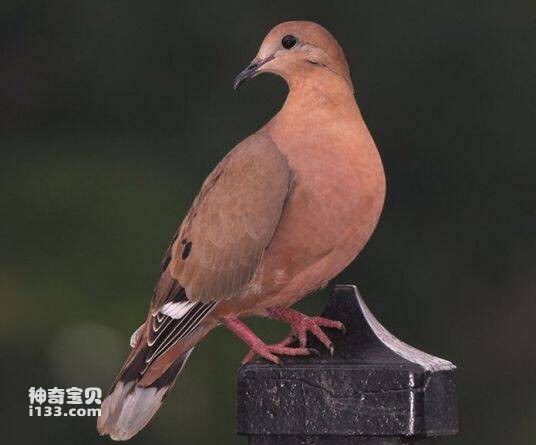Zenaida aurita
IUCN
LCBasic Information
Scientific classification
- name:Zenaida aurita
- Scientific Name:Zenaida aurita,Zenaida Dove
- Outline:Landfowl
- Family:
Vital signs
- length:28-30.5cm
- Weight:120-180g
- lifetime:No textual research information is available
Feature
It looks like a mourning dove, but is smaller in size, with a shorter, rounded tail and a darker color
Distribution and Habitat
Found in Anguilla, Antigua, Barbuda, The Bahamas, Barbados, Bonaire, Saint Eustatius and Saba, Cayman Islands, Cuba, Curacao, Dominica, Grenada, Guadeloupe, Haiti, Jamaica, Martinique, Mexico, Montserrat, Puerto Rico, Saint Kitts and Nevis, Saint Lucia, Saint Martin, Puerto Rico. Saint Vincent and the Grenadines, Saint Martin, Turks and Caicos Islands, Virgin Islands, United States.
It inhabits open woodlands, forest margins, forest clearings, sparse forests, shrubbery areas, cultivated lands, gardens and mangroves. Build a nest in a crack in the rock, on a cliff, or on a branch of a tree. Including urban areas, farmland, pasture, grassland and woodland areas, do not like swamps and dense forests.
Appearance
There are three subspecies of mourning pigeons, with a body length of 28-30.5 cm and a weight of 149-180 g for males and 120-145 g for females. They are similar in appearance to mourning pigeons, but smaller in size, with shorter, rounder tails, and darker in color. The mourning dove has some white edges on its wings. The body plumage is generally reddish gray-brown, with lighter underwings and white fringes, and the head and thorax are cinnamon red. There are iridescent purple patches on the side of the neck, two dark purple-blue stripes on the side of the face, black spots on the wings, and a rounded tail with white tail feathers on the outer layer that contrast strongly with the black feathers on the inner layer. The eyes are black with thin skin around them. Female adult birds differ little from males in body size, but generally have darker plumage than males. Very few males have patches of colored feathers above the shoulders and on the neck. The chicks have darker plumage.
The
Details
The mourning Dove (Zenaida aurita) has three subspecies.

Mourning pigeons feed on the ground, mainly on shells and seeds, and sometimes insects. They tend to forage near water, often in pairs or small groups, and often swallow coarse sand, such as small grit and sand, to aid digestion. It mainly eats plant seeds, both native and exotic plants. The cry of the mourning dove is similar to that of the mourning dove, but it is a little faster and shorter, and its cry often gives people a feeling of sadness, from which it is named. The song is very characteristic, it sounds like "gu-gu-gu-woo-woo" (" gu "is stressed and then fades away. A grinding and clucking sound in the throat can be heard before the first "goo"), which is a call used by male birds to attract mates. There is also a soft tut, described as "coo-oo, COO, COO, COO or 'hoo' ooo OO-OO-OOO."
Mourning pigeons can use a series of different calls to communicate with other mourning pigeons. For example, male birds can use "goo ~" to call their mates to return to the nest. Males looking for a new mate greet females with a soft "oh" sound; When threatened, both male and female birds use a short "noo-noo" sound as an alarm. As it flies, the flapping of its wings makes an unpleasant whistling sound. The howl is even louder during takeoff and landing.
Mourning pigeons are monogamous and join together to form intimate partners. Nesting in a tree or shrub will produce two eggs at a time. In the absence of predators, they nest in crevices and vegetation. The incubation period is about 2 weeks, and the young birds usually moult at 2 weeks of age. Both parents feed their chicks with cud. During the breeding period, mourning pigeon pairs in the same area sometimes seek new mates; And sometimes partners stay fixed and spend the winter together. In addition, lone pigeons also seek new mates when they need them. Mourning pigeons are very fertile, a pair of mourning pigeons often lay two to three broods per year, and in the breeding season in warm areas, a pair of mourning pigeons can lay up to four broods a year. The adult bird has an unusual "crop" with which it feeds its newly hatched chicks. The crop milk is rich in energy and nutrients, making the young pigeons grow quickly. They are followed by seeds. The adult birds take care of the young birds for 13 to 15 days until all their feathers have grown out.
Listed on the International Union for Conservation of Nature (IUCN) 2012 Red List of Threatened Species ver 3.1 - Low Risk (LC).
Protect wild animals and eliminate wild meat.
Maintaining ecological balance is everyone's responsibility!








